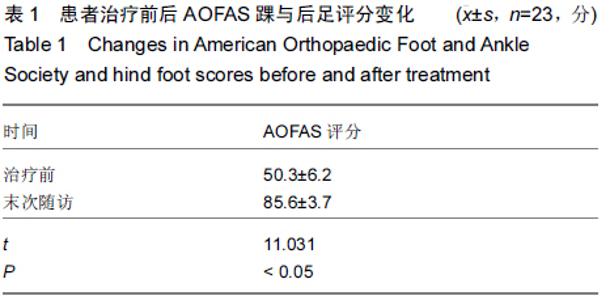| [1] |
Hu Kai, Qiao Xiaohong, Zhang Yonghong, Wang Dong, Qin Sihe.
Treatment of displaced intra-articular calcaneal fractures with cannulated screws and plates: a meta-analysis of 15 randomized controlled trials
[J]. Chinese Journal of Tissue Engineering Research, 2021, 25(9): 1465-1470.
|
| [2] |
Huang Dengcheng, Wang Zhike, Cao Xuewei.
Comparison of the short-term efficacy of extracorporeal shock wave therapy for middle-aged and elderly knee osteoarthritis: a meta-analysis
[J]. Chinese Journal of Tissue Engineering Research, 2021, 25(9): 1471-1476.
|
| [3] |
Zhang Tongtong, Wang Zhonghua, Wen Jie, Song Yuxin, Liu Lin.
Application of three-dimensional printing model in surgical resection and reconstruction of cervical tumor
[J]. Chinese Journal of Tissue Engineering Research, 2021, 25(9): 1335-1339.
|
| [4] |
Peng Zhihao, Feng Zongquan, Zou Yonggen, Niu Guoqing, Wu Feng.
Relationship of lower limb force line and the progression of lateral compartment arthritis after unicompartmental knee arthroplasty with mobile bearing
[J]. Chinese Journal of Tissue Engineering Research, 2021, 25(9): 1368-1374.
|
| [5] |
Liu Xiangxiang, Huang Yunmei, Chen Wenlie, Lin Ruhui, Lu Xiaodong, Li Zuanfang, Xu Yaye, Huang Meiya, Li Xihai.
Ultrastructural changes of the white zone cells of the meniscus in a rat model of early osteoarthritis
[J]. Chinese Journal of Tissue Engineering Research, 2021, 25(8): 1237-1242.
|
| [6] |
Zeng Yanhua, Hao Yanlei.
In vitro culture and purification of Schwann cells: a systematic review
[J]. Chinese Journal of Tissue Engineering Research, 2021, 25(7): 1135-1141.
|
| [7] |
Cao Xuhan, Bai Zixing, Sun Chengyi, Yang Yanjun, Sun Weidong.
Mechanism of “Ruxiang-Moyao” herbal pair in the treatment of knee osteoarthritis based on network pharmacology
[J]. Chinese Journal of Tissue Engineering Research, 2021, 25(5): 746-753.
|
| [8] |
Li Yonghua, Feng Qiang, Tan Renting, Huang Shifu, Qiu Jinlong, Yin Heng.
Molecular mechanism of Eucommia ulmoides active ingredients treating synovitis of knee osteoarthritis: an analysis based on network pharmacology
[J]. Chinese Journal of Tissue Engineering Research, 2021, 25(5): 765-771.
|
| [9] |
Song Shan, Hu Fangyuan, Qiao Jun, Wang Jia, Zhang Shengxiao, Li Xiaofeng.
An insight into biomarkers of osteoarthritis synovium based on bioinformatics
[J]. Chinese Journal of Tissue Engineering Research, 2021, 25(5): 785-790.
|
| [10] |
Deng Zhenhan, Huang Yong, Xiao Lulu, Chen Yulin, Zhu Weimin, Lu Wei, Wang Daping.
Role and application of bone morphogenetic proteins in articular cartilage regeneration
[J]. Chinese Journal of Tissue Engineering Research, 2021, 25(5): 798-806.
|
| [11] |
Xu Dongzi, Zhang Ting, Ouyang Zhaolian.
The global competitive situation of cardiac tissue engineering based on patent analysis
[J]. Chinese Journal of Tissue Engineering Research, 2021, 25(5): 807-812.
|
| [12] |
Liu Xin, Yan Feihua, Hong Kunhao.
Delaying cartilage degeneration by regulating the expression of aquaporins in rats with knee osteoarthritis
[J]. Chinese Journal of Tissue Engineering Research, 2021, 25(5): 668-673.
|
| [13] |
Ma Zetao, Zeng Hui, Wang Deli, Weng Jian, Feng Song.
MicroRNA-138-5p regulates chondrocyte proliferation and autophagy
[J]. Chinese Journal of Tissue Engineering Research, 2021, 25(5): 674-678.
|
| [14] |
Wu Zijian, Hu Zhaoduan, Xie Youqiong, Wang Feng, Li Jia, Li Bocun, Cai Guowei, Peng Rui.
Three-dimensional printing technology and bone tissue engineering research: literature metrology and visual analysis of research hotspots
[J]. Chinese Journal of Tissue Engineering Research, 2021, 25(4): 564-569.
|
| [15] |
Chang Wenliao, Zhao Jie, Sun Xiaoliang, Wang Kun, Wu Guofeng, Zhou Jian, Li Shuxiang, Sun Han.
Material selection, theoretical design and biomimetic function of artificial periosteum
[J]. Chinese Journal of Tissue Engineering Research, 2021, 25(4): 600-606.
|



